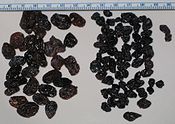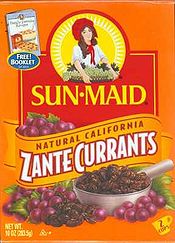
Zante currant
Encyclopedia

Grape
A grape is a non-climacteric fruit, specifically a berry, that grows on the perennial and deciduous woody vines of the genus Vitis. Grapes can be eaten raw or they can be used for making jam, juice, jelly, vinegar, wine, grape seed extracts, raisins, molasses and grape seed oil. Grapes are also...
variety Black Corinth (Vitis vinifera
Vitis vinifera
Vitis vinifera is a species of Vitis, native to the Mediterranean region, central Europe, and southwestern Asia, from Morocco and Portugal north to southern Germany and east to northern Iran....
). The name comes from the Anglo-French
Anglo-Norman language
Anglo-Norman is the name traditionally given to the kind of Old Norman used in England and to some extent elsewhere in the British Isles during the Anglo-Norman period....
phrase "raisins de Corinthe" (raisins of Corinth) and the Ionian
Ionian Islands
The Ionian Islands are a group of islands in Greece. They are traditionally called the Heptanese, i.e...
island of Zakynthos
Zakynthos
Zakynthos , also Zante, the other form often used in English and in Italian , is a Greek island in the Ionian Sea. It is the third largest of the Ionian Islands. It is also a separate regional unit of the Ionian Islands region, and the only municipality of the regional unit. It covers an area of ...
(Zante), which was once the major producer and exporter. It is not related to black
Blackcurrant
Blackcurrant, Ribes nigrum, is a species of Ribes berry native to central and northern Europe and northern Asia, and is a perennial....
, red
Redcurrant
The redcurrant , Ribes rubrum, is a member of the genus Ribes in the gooseberry family Grossulariaceae, native to parts of western Europe...
or white currant
White currant
The white currant , sometimes called the pink or yellow currant, is a member of the genus Ribes. The flowers are a pale yellow-green, maturing into translucent berries with a pink to white hue.- White and red :...
s, which are berries of shrubs in the Ribes
Ribes
Ribes is a genus of about 150 species of flowering plants native throughout the temperate regions of the Northern Hemisphere. It is usually treated as the only genus in the family Grossulariaceae. Seven subgenera are recognized....
genus.
History
The currant is one of the oldest known raisins. The first written record was in 75 AD by Pliny the ElderPliny the Elder
Gaius Plinius Secundus , better known as Pliny the Elder, was a Roman author, naturalist, and natural philosopher, as well as naval and army commander of the early Roman Empire, and personal friend of the emperor Vespasian...
, who described a tiny, juicy, thick-skinned grape with small bunches. The next mention is a millennium later, when the raisins became a subject of trade between Venetian
Republic of Venice
The Republic of Venice or Venetian Republic was a state originating from the city of Venice in Northeastern Italy. It existed for over a millennium, from the late 7th century until 1797. It was formally known as the Most Serene Republic of Venice and is often referred to as La Serenissima, in...
merchants and Greek producers from Ionian coasts. In the 14th century, they were sold in the English market under the label Reysyns de Corauntz, and the name raisins of Corinth
Corinth
Corinth is a city and former municipality in Corinthia, Peloponnese, Greece. Since the 2011 local government reform it is part of the municipality Corinth, of which it is the seat and a municipal unit...
was recorded in the 15th century, after the Greek harbor which was the primary source of export. Gradually, the name got corrupted into currant. However, by the 17th century, the trade shifted towards the Ionian islands, particularly Zakynthos (Zante), after which it was named Zante currant.
The first attempts to introduce the Black Corinth in the United States date back to 1854. The first successful vineyards of White and Red Corinth (related varieties), were established in California in 1861, by Colonel Agoston Haraszthy
Agoston Haraszthy
Agoston Haraszthy was a Hungarian-American traveler, writer, town-builder, and pioneer winemaker in Wisconsin and California, often referred to as the "Father of California Viticulture," or the "Father of Modern Winemaking in California"...
. Around 1901, David Fairchild
David Fairchild
David Grandison Fairchild was an American botanist and plant explorer. Fairchild was responsible for the introduction of more than 200,000 exotic plants and varieties of established crops into the United States, including soybeans, pistachios, mangos, nectarines, dates, bamboos, and flowering...
of USDA imported high-quality Black Currant cuttings from Greek village of Panariti, a renowned producer, establishing first commercial crops. However, the American production remained modest because of higher popularity of Thompson Seedless, up to 1920s and 1930s, when its popularity increased, due to higher prices and improved cultivation practices (girdling). The plantings reached 3000 acres (1,214.1 ha) by 1936, which is approximately its current level.
Description
Black Corinth grape variety is probably of ancient Greek origin.In wild grapes, the species is dioecious
Dioecious
Dioecy is the property of a group of biological organisms that have males and females, but not members that have organs of both sexes at the same time. I.e., those whose individual members can usually produce only one type of gamete; each individual organism is thus distinctly female or male...
; the sexes grow on separate vines with male flowers on one plant, and female flowers on another. Black Corinth is an "almost male" variety in that the flowers have well-developed anthers (male), but only tiny underdeveloped ovaries (female).
Clusters of Black Corinth are small, averaging 0.4 pound (0.181436948 kg), ranging from 0.2 to 0.6 pounds. They are cylindrical, with prominent shoulder or winged. The berries are very small (0.35–0.6 grams), round, of reddish black color. Skin is very thin, and the flesh is juicy and soft. It is practically seedless, except in occasional large berry. When dried, raisins weigh 0.09–0.14 grams, and receive dark brown or black color. Leaves are
medium-sized, heart-shaped and oblong. They are five-lobed with deep sinuses.
Cultivation

Girdling
Girdling, also called ring barking or ring-barking, is the complete removal of a strip of bark from around the entire circumference of either a branch or trunk of a woody plant. Girdling results in the death of wood tissues beyond the damage...
was a standard practice to increase the set and size of seedless grapes, until the discovery of the plant hormone gibberellic acid
Gibberellic acid
Gibberellic acid Gibberellic acid Gibberellic acid (also called Gibberellin A3, GA, and (GA3) is a hormone found in plants. Its chemical formula is C19H22O6. When purified, it is a white-to-pale-yellow solid....
, and its ability to do the same thing with less labor. Historically, Black Corinth stock was probably kept for its pollen-producing abilities, so other female flowered varieties (with naturally higher yields) would set full crops.
The Black Corinth variety is also reputed to be very prone to powdery mildew
Powdery mildew
Powdery mildew is a fungal disease that affects a wide range of plants. Powdery mildew diseases are caused by many different species of fungi in the order Erysiphales. It is one of the easier diseases to spot, as its symptoms are quite distinctive. Infected plants display white powdery spots on the...
and susceptible to numerous other diseases, such as downy mildew
Downy mildew
Downy mildew refers to any of several types of oomycete microbes that are obligate parasites of plants. Downy mildews exclusively belong to Peronosporaceae. In commercial agriculture, they are a particular problem for growers of crucifers, grapes and vegetables that grow on vines...
and black rot
Black rot
Black rot is a name used for various diseases of cultivated plants caused by fungi or bacteria, producing dark brown discoloration and decay in the leaves of fruit and vegetables:...
.
Greece is still the primary producer of currants, amounting to about 80% of total world production, with California, South Africa and Australia sharing most of the remainder.
Culinary use
Zante currants are very small and intensely flavoured. They can be eaten raw, especially when ripe, when they are sweet to the taste. They may also be referred to as table grapes for this purpose. More commonly, they are used for making raisinRaisin
Raisins are dried grapes. They are produced in many regions of the world. Raisins may be eaten raw or used in cooking, baking and brewing...
s, and occasionally, wine
Wine
Wine is an alcoholic beverage, made of fermented fruit juice, usually from grapes. The natural chemical balance of grapes lets them ferment without the addition of sugars, acids, enzymes, or other nutrients. Grape wine is produced by fermenting crushed grapes using various types of yeast. Yeast...
. When dried, they are often called "dried currants" or just "currants", and in this form are used in cooking, especially baking and are a major ingredient in currant slice (or currant square) and currant cake. Unlike blackcurrants, Zante currants are not a significant source of vitamin C.
In the United Kingdom
United Kingdom
The United Kingdom of Great Britain and Northern IrelandIn the United Kingdom and Dependencies, other languages have been officially recognised as legitimate autochthonous languages under the European Charter for Regional or Minority Languages...
, they are usually called simply "currants", and often are used in scones
Scone (bread)
The scone is a small Scottish quick bread especially popular in the United Kingdom, the United States, Canada, Australia, New Zealand,Belgium and Ireland, but are also eaten in many other countries. They are usually made of wheat, barley or oatmeal, with baking powder as a leavening agent...
, currant bun
Currant bun
A currant bun is a bun that contains currants or raisins.The Chelsea bun is a variant. Neither should be confused with a spiced bun.Currant Bun is English rhyming slang for the tabloid newspaper The Sun.-History of currant buns:...
s, Christmas cake
Christmas cake
Christmas cake is a type of fruitcake served at Christmas time in the UK, Ireland, Japan, Philippines and many Commonwealth countries.A Christmas cake may be light or dark, crumbly-moist to sticky-wet, spongy to heavy, leavened or unleavened, shaped round, square or oblong as whole cakes, fairy...
, Christmas pudding
Christmas pudding
Christmas pudding is a pudding traditionally served on Christmas Day . It has its origins in medieval England, and is sometimes known as plum pudding or plum duff, though this can also refer to other kinds of boiled pudding involving dried fruit.-Basics:Many households have their own recipe for...
and mincemeat
Mincemeat
Mincemeat is a mixture of chopped dried fruit, distilled spirits and spices, and sometimes beef suet, beef, or venison. Originally, mincemeat always contained meat. Many modern recipes contain beef suet, though vegetable shortening is sometimes used in its place...
. They are sometimes sold mixed with raisin
Raisin
Raisins are dried grapes. They are produced in many regions of the world. Raisins may be eaten raw or used in cooking, baking and brewing...
s and sultanas
Sultana (grape)
The sultana is a type of white, seedless grape assumed to originate from the Turkish, Greek, or Iranian area...
as "mixed dried fruit
Fruit
In broad terms, a fruit is a structure of a plant that contains its seeds.The term has different meanings dependent on context. In non-technical usage, such as food preparation, fruit normally means the fleshy seed-associated structures of certain plants that are sweet and edible in the raw state,...
".
The fresh fruit is often marketed under the name "Champagne grapes" in U.S. specialty stores, but despite the name, they are not used for making Champagne.

